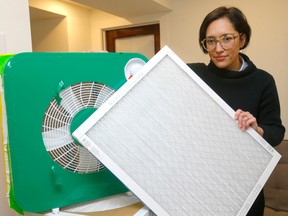Sabrina Maddeaux: When it comes to controlling COVID, it’s the ventilation, stupid
To win this battle over the long term and fend off future pandemics, Canada will have to get serious about upgrading its ventilation standards

Article content
We’ve long known improving indoor air quality is key to not only controlling COVID-19, but preventing transmission of other viruses, as well. While vaccines and rapid tests are certainly important, they are only part of the puzzle.
There will always be people who choose to forgo vaccines, and that percentage is likely to increase if booster shots are required on a continuing basis. Laziness, skepticism and indifference will eventually set in. Rapid tests, while certainly the trending solution at the moment, aren’t a panacea, either.
To win this battle over the long term and fend off future pandemics, Canada will have to get serious about upgrading its ventilation standards — particularly in high-risk settings.
“It’s an airborne disease. I think that’s clear,” said Dr. Adalsteinn Brown, co-chair of the Ontario COVID-19 Science Advisory Table at a press conference on Thursday. This shouldn’t be a remarkable quote, but it is. While the science on this has been clear for at least a year and a half, Canadian health officials and politicians were either unable or unwilling to accept the evidence. Many are still reluctant.
In contrast to Brown’s statement, Ontario’s chief medical officer of health, Dr. Kieran Moore, said on Wednesday that he’s concerned Omicron may be airborne, which he called a “game-changer.” The response from the medical community on Twitter could best be described as a collective eye roll.
On a federal level, Canada remains an outlier among peer nations for refusing to acknowledge airborne transmission, let alone educate the public about aerosols or update guidelines and public health controls to prevent this type of spread.
Canada is still largely a country obsessed with sanitization. While once a reasonable precautionary measure, it has become reflective of Canada’s overall approach to problem solving: cheap and easy trumps expensive and effective. We’re not a country that likes to think about, talk about or do hard things.
For the record, the U.S. C enters for Disease Control and Prevention (CDC) states that the risk of transmission from contact with a contaminated surface is “low,” at less than one in 10,000. However, the amount of money and effort put into sanitizing surfaces by governments, businesses and individuals has created a sunk cost fallacy where we collectively refuse to move on, even as we preach “following the science.”
We should’ve used calm periods during the summer and fall to update public guidance and begin a necessary overhaul of the country’s ventilation standards and systems. While this will obviously be an ongoing process, urgency should’ve been given to settings like long-term care homes and schools, followed by high-risk employment venues like meatpacking plants and warehouses, then social settings like entertainment venues, restaurants and bars, where masks can’t always be worn.
But better late than never. The time to reconcile with reality and turbocharge our ventilation efforts is now. Governments and public health officials must immediately and publicly acknowledge that COVID is airborne.
They should co-ordinate to provide guidance and incentives to businesses and building owners to improve ventilation as quickly as possible. Air filtration systems using technologies such as HEPA filters and ultraviolet lights should be in widespread use.
There must be a strong signal that safe air standards will become as important as any other health and safety standard that private businesses, public buildings, employers, developers and landlords must meet. We have clean water standards, food safety standards and property maintenance standards; improved ventilation should be no different.
One of the best ways to encourage private interests to quickly improve ventilation is to make air quality transparency the norm. This means equipping buildings with air quality monitors that anyone entering the premises can read and use to make informed decisions. This is yet another way to put control back in the hands of individuals rather than relying on broad and overbearing restrictions.
We will have to learn to live with this virus –– and likely, eventually, others. Improved air quality isn’t optional; it’s key to getting back to “normal” and pandemic-proofing Canadian society. The sooner we prioritize it, the better.
National Post
The big issues are far from settled. Sign up for the NP Comment newsletter, NP Platformed.











Postmedia is committed to maintaining a lively but civil forum for discussion. Please keep comments relevant and respectful. Comments may take up to an hour to appear on the site. You will receive an email if there is a reply to your comment, an update to a thread you follow or if a user you follow comments. Visit our Community Guidelines for more information.